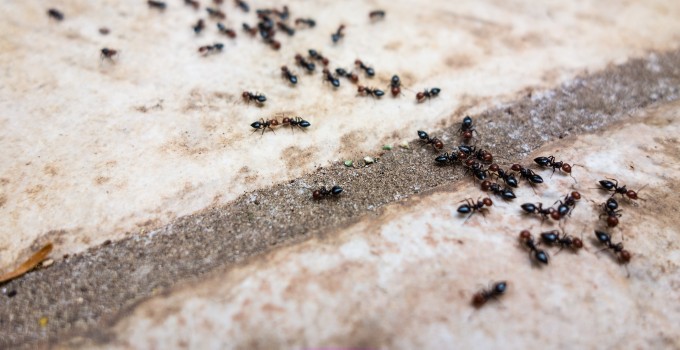It’s spring, and the beautiful weather outside is calling. Unfortunately, it’s also calling insects to invade your yard and home. The worst case scenario for homeowners in Wilkes-Barre, PA is structural damage. Wood-destroying insects like carpenter ants and termites probably come to mind when you think of homes falling victim to dangerous pests. What are carpenter ants and termites? How can you tell the difference between carpenter ant damage and termite damage? Our pest pros have the answers to these questions and more.
What do termites and carpenter ants look like?
Before you panic, look at the insects and see if you have a termite or carpenter ant infestation.
Eastern Subterranean Termites
The most destructive type of termite in Wilkes-Barre, PA is the eastern subterranean termite. These pests can cause significant damage to wood structures and furnishings. Their appearance varies depending on their role in the colony and the stage of their lifecycle. Queen termites are extremely large and can lay up to 2,000 eggs every day. Worker termites are the most numerous. These tiny bugs are soft-bodied and translucent, at about 1/8 inch long. Soldier termites are significantly larger and have orange armored heads and mandibles. Swarmers are the winged termites that move from the old colony to forge new homes. These are the easiest to recognize, as they fly during the day to swarm. They’re dark brown and about 3/8 inch long.
Carpenter Ants
The appearance of carpenter ants also varies according to their role, with worker ants ranging from 1/4 to 1/2 inch long. They’re much larger than common nuisance ants that you’ll find trailing in kitchens and bathrooms in Wilkes-Barre, PA, so it’s fairly easy to tell the difference. Male carpenter ants and queens are generally larger than worker ants and have wings. This makes it easy to confuse them when you’re wondering if an insect is a termite or carpenter ant. Carpenter ants are nocturnal pests, so you may catch them wandering around at night.
Termites and Carpenter Ants: Differences in Behavior
While carpenter ants can damage wood, they tend to be attracted to wood that is already damaged by decay and water damage. They may eventually work their way to fresh wood, but it can take quite a long time. Carpenter ants prefer rotted wood, but you can also find them invading tree stumps and wood piles around your property. Carpenter ants chew their nests in wood to build shelter, rather than consuming it like termites do. As they tunnel through damp wood or insulation, carpenter ants chew the material and spit it back out. Small piles of what looks like wood shavings are left from the displaced wood at the entry and exit points. If you are finding small piles of wood shavings around your home, it could be the result of carpenter ant nesting. Eastern subterranean termites on the other hand, eat wood. They are attracted to moisture that can exist around your property and even up against your home.
How can I tell if I have carpenter ant or termite damage?
Have you ever wondered what carpenter ant damage and termite damage look like? It’s very possible that you can have an infestation without ever seeing the actual bugs. Identifying their damage will help give you clues as to what kind of wood-destroying insect in nesting in your home. Both carpenter ants and subterranean termites destroy wood including some of the most important parts of your home like structural beams, window and door frames, and more.
Termites may make underground tunnels or above-ground “shelter tubes” of mud, feces and debris used to search for new food sources and to connect their nest to their food. These tubes are often visible in basements. Signs of termite damage include:
- Pencil-sized diameter, or larger, mud tubes running across bare concrete or masonry between the soil and any wooden part of your home.
- Thin, small, papery wings, all the same size and shape, 3/8-1/2 in. long, on your window sill, counter top or floor (especially if it is late spring and there has been a recent rain).
- Thin, “bubbled” or distorted areas of paint on wooden surfaces, especially if these feel cool to the touch.
- Any wooden elements within the home (especially if they are important support structures) beginning to “sag” unexpectedly.
Carpenter ants create smooth galleries while nesting within soft wood and insulation. Because the damage is nearly always internal, piles of frass are your best indicator of carpenter ant infestations. And while carpenter ants can damage your home, it will take them a long time before doing significant damage to good wood. Termites, on the other hand, cause $5 billion dollars of building damage every year. It only takes three to five years for a termite colony to cause major damage to your home.
How can Seitz Bros. get rid of carpenter ants and termites in my home?
The Home Protection Plan
Our Home Protection Plan provides homeowners with year-round coverage against recurring insect or rodent problems, including carpenter ants. Covered pests include carpenter ants, bees, centipedes, crickets, hornets, mice, rats, stink bugs, wasps, yellow jackets, brown dog ticks, and more. The plan comes with unlimited technician visits to ensure your pest problem is solved. Monthly and quarterly options are available.
Short-term targeted services are available through our One-Time Carpenter Ant Control Plan.
Termite Control
Liquid Termite Service
This application provides a continuously treated zone around the structures entire foundation, plus localized interior applications to areas with known termite activity. For structures with accessible crawl space construction, Seitz Brothers must also treat around all piers and pipes inside the crawl, regardless if termites are present. This liquid application requires fewer chemicals than conventional treatments and is less invasive and disruptive to you, the homeowner. The active agent within the liquid is slow acting and non-repellent to the termites. It allows the termites to continue their normal routine; thus the exposed termites transfer the termiticide to a large number of colony members before dying themselves.
Termite Baiting Program
The Seitz Brothers Termite Baiting System is the best approach for protecting structures from subterranean termites because it eliminates the colony, while being non-disruptive to property owners. This program takes advantage of natural termite behavior. Worker termites constantly forage far and wide, looking for wood to feed the colony. When they find food, like the monitoring device in a bait station, they leave special scent trails to summon their nest mates to the food source.
Once your Seitz Brothers Termite Control Technician discovers termites feeding in the station, the monitoring device is replaced with a bait tube. The bait contains a substance that stops the molting process so termites can’t grow. In time, the termites in the colony will be affected by the bait and die.
Termite Renewal Plan
The purpose of the Termite Renewal Plan is to provide the homeowner with not only a thorough annual inspection but also to provide valuable information that will help the homeowner take certain steps to prevent unnecessary termite problems. Inspections and service calls can be placed throughout the year if the homeowner finds termites or conditions that they suspect could be a termite problem. Treatments will take place if an active termite infestation is found. This plan is able to be renewed on an annual basis.
Call us or fill out the contact form on this page to learn more about our carpenter ant and termite control plans or to schedule a free inspection!
What Is the Difference Between Carpenter Ants and Termites in Wilkes-Barre, PA Pest Control in Pennsylvania & New Jersey?
Serving Northeast & Central PA | Lehigh Valley | Pocono Mountains | Western NJ

